Page last updated Nov 28, 2021
PGC 64054
(= ESO 461-036)
A magnitude 16.5(?) irregular galaxy (type dIrr?) in Sagittarius (RA 20 03 56.3, Dec -31 41 04)
Physical Information: Based on a recessional velocity relative to the Cosmic Microwave Background radiation of 235 km/sec (and H0 = 70 km/sec/Mpc), PGC 64054 is about 11 million light years away, in poor agreement with redshift-independent distance estimates of about 20 to 25 million light years. The poor agreement is perfectly understandable, as "peculiar velocities" (the random motions of galaxies relative to other objects in their vicinity) are often a hundred or more km/sec; as a result, for an object with such a low recessional velocity the "Hubble Flow" distance is less reliable than other methods of determining distance. The mean of the redshift-independent distance estimates (about 24 to 25 million light years) is therefore almost certainly a more reliable indicator of the distance of PGC 64054, and I have used that distance for the following calculation. Given that, the galaxy's apparent size of about 1.15 by 0.75 arcmin (from the images below) corresponds to about 8 thousand light years, hence its designation as a "dwarf" iregular galaxy.
Maps of the distribution of galaxies show that they tend to be found within irregular networks of "strings" and "clumps" filled with galaxies and clusters of galaxies, wrapped around "bubbles" that are nearly or completely devoid of such structures. (As of May, 2020) PGC 64054 was the only object certainly known to lie within the "Local Void", the nearest such "vast empty region" (though another fifteen galaxies had been tentatively identified as lying within the region). The Local Void's nearest approach to the Local Sheet (the region which includes our galaxy and all the other galaxies within the Local Group and other nearby galaxies) is about 17 or 18 million light years distant, and the Void extends for at least 150 million light years beyond that, and (counting two other voids which appear to be more or less connected to it) perhaps as much as 400 million light years. All the other galaxies which appear in the HST image of PGC 64054 lie well beyond the Void, and are much more distant background objects (whereas many of the stars seen in the image, especially the brighter ones, lie within our own galaxy and are for all practical purposes infinitely closer than PGC 64054).
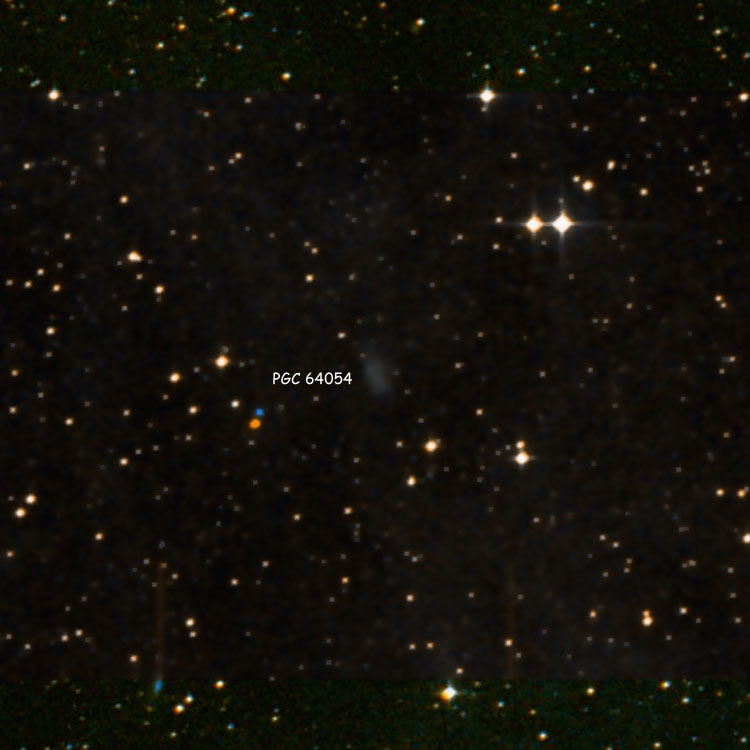
Above, a 12 arcmin wide DSS image centered on PGC 64054
Below, a 1.4 by 1.5 arcmin wide HST image of the galaxy
(Image Credit ESA/Hubble & NASA, E. Shaya, L. Rizzi, B. Tully, et al.)

Below, the image above enhanced to show the full extent of the galaxy (Post-processing by Courtney Seligman)
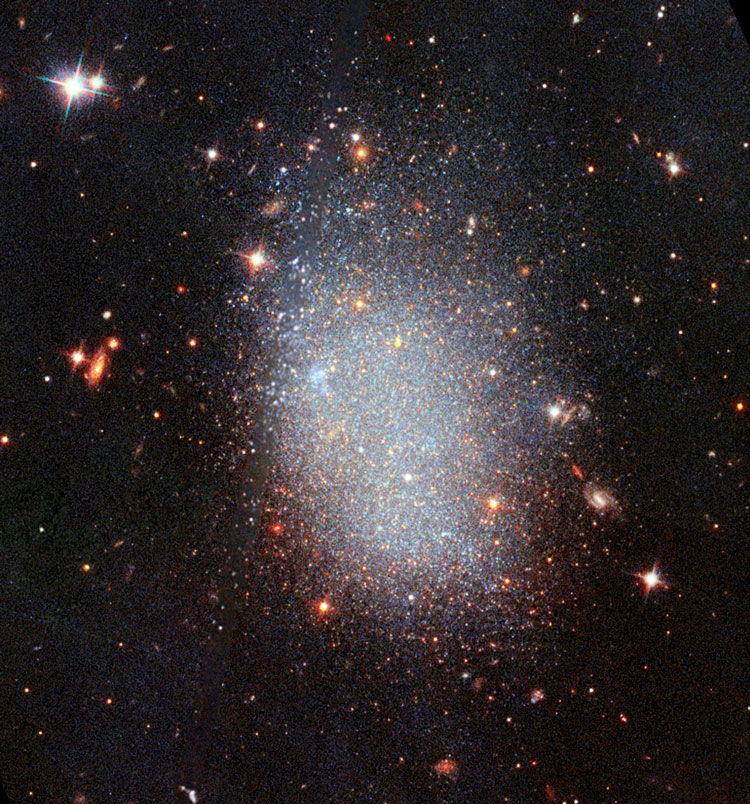
PGC 64422
(= ESO 340-008)
A magnitude 15(?) spiral galaxy (type Sd: sp / E(d)8) in Sagittarius (RA 20 17 11.8, Dec -40 55 25)
Physical Information: Based on a recessional velocity of 2665 km/sec (and H0 = 70 km/sec/Mpc), PGC 64422 is about 125 million light years away, in good agreement with redshift-independent distance estimates of about 115 to 175 million light years. Given that and its apparent size of about 2.45 by 0.15 arcmin (from the images below), it is about 85 to 90 thousand light years across.
Classification Note: The type is taken from the Spitzer Survey of Stellar Structure in Galaxies. "sp" stands for "spindle" (that is, an "edge-on" galaxy), which makes classification more difficult (hence "d:", meaning probably type d, but perhaps type cd). "/ E(d)8" means that the galaxy is enveloped in an elliptically-shaped disklike outer region; but "true" ellipticals rarely go beyond class E4 to E5, and in any case, the outer region's shape does not alter the fact that this is a spiral galaxy.

Above, a 12 arcmin wide DSS image centered on PGC 64422
Below, a 2.75 arcmin wide DSS image centered on the galaxy

PGC 64429
(= PGC 606424 = ESO 340-009 = MCG -06-44-026)
A magnitude 14(?) galaxy (type S(AB?)d: sp) in Sagittarius (RA 20 17 20.5, Dec -38 40 25)
Physical Information: Based on a recessional velocity of 2430 km/sec (and H0 = 70 km/sec/Mpc), PGC 64429 is about 110 to 115 million light years away, in good agreement with redshift-independent distance estimates of about 85 to 130 million light years. Given that and its apparent size of about 2.35 by 0.25 arcmin (from the images below), it is about 75 to 80 thousand light years across.
Classification Note: The type is taken from the Spitzer Survey of Stellar Structure in Galaxies. The colon following the "d" means that part of the classification is not as certain as the authors would have liked, partly because of the "sp", indicating that this is a "spindle" galaxy (that is, "edge-on"), which makes determining the classification more difficult than usual. (For the same reason, it's not obvious whether it is a barred or unbarred galaxy.)
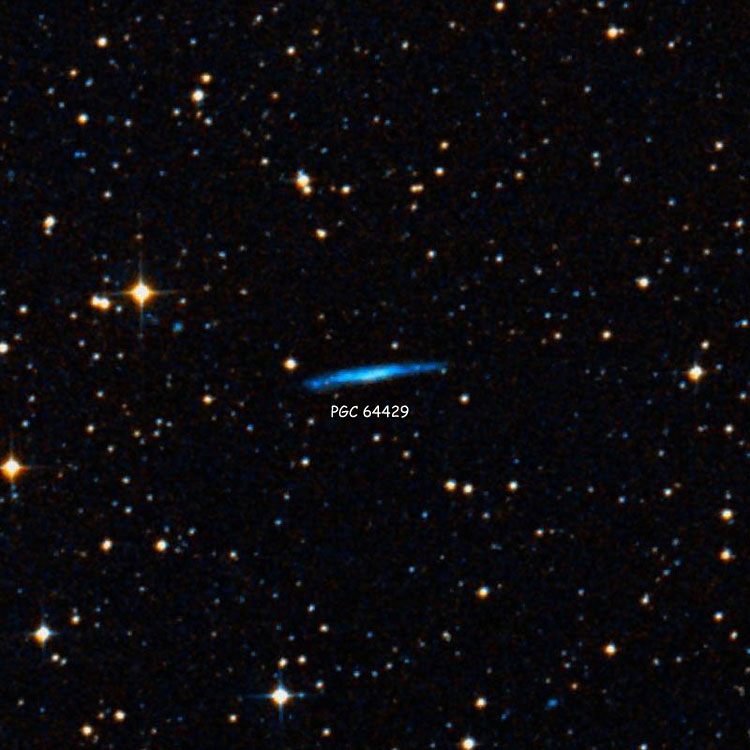
Above, a 12 arcmin wide DSS image centered on PGC 64429
Below, a 3 arcmin wide DSS image of the galaxy
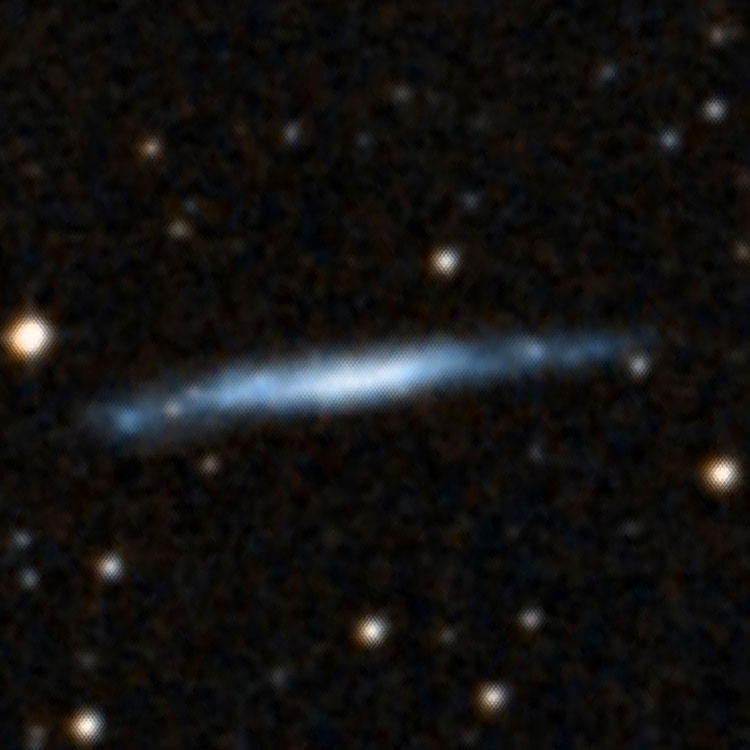
PGC 64450 (usually (mis)identified as IC 4991)
(= ESO 340-011)
A magnitude 11.5 lenticular galaxy (type SA(r)0?) in Sagittarius (RA 20 18 23.3, Dec -41 03 00)
Historical Misidentification: As discussed in the entry for IC 4991, that is almost certainly a lost or nonexistent object. However, PGC 64450 is often (if not usually) misidentified as IC 4991, so there is an entry discussing PGC 64450 here.
WORKING HERE
PGC 64456 (= ESO 340-013)
A magnitude 14(?) lenticular galaxy (type SB(rl)0/a?) in Sagittarius (RA 20 18 37.6, Dec -41 03 17)
Physical Information: Based on a recessional velocity relative to the Cosmic Microwave Background radiation of 5710 km/sec (and H0 = 70 km/sec/Mpc), PGC 64456 is about 265 to 270 million light years away. Given that and its apparent size of about 0.95 by 0.9 arcmin (from the images below), the galaxy is about 70 to 75 thousand light years across. The galaxy to its west ( PGC 64450) has a similar recessional velocity (5480 km/sec relative to the CMB), so the two are probably at a similar distance from us (their Hubble Flow distances differ by only about 10 million light years), but whether they are close enough to each other to be physical companions is not at all certain, and is only suggested by the fact that both have slightly unusual structures.
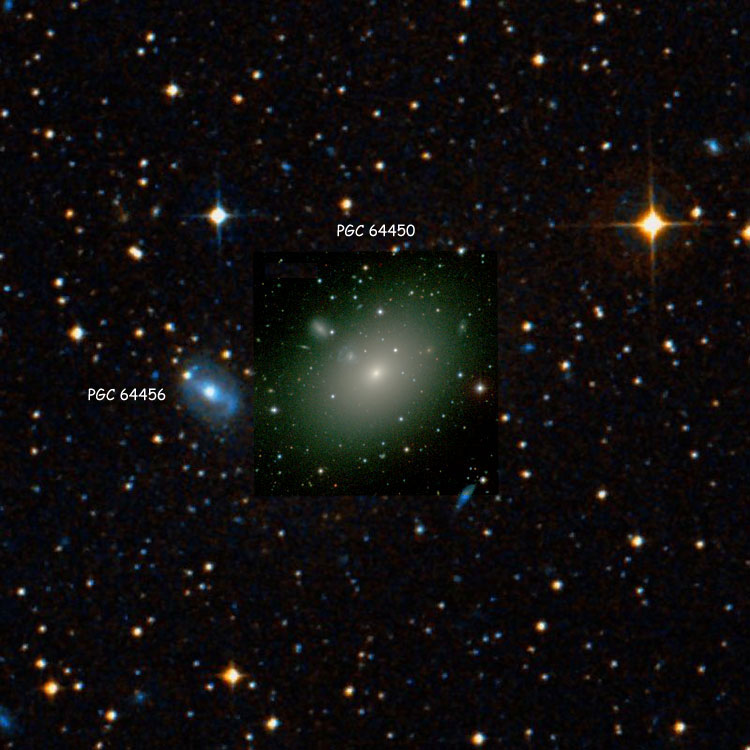
Above, a 12 arcmin wide image centered on PGC 64450, also showing PGC 64456
Below, a 1.3 arcmin wide DSS image of PGC 64456
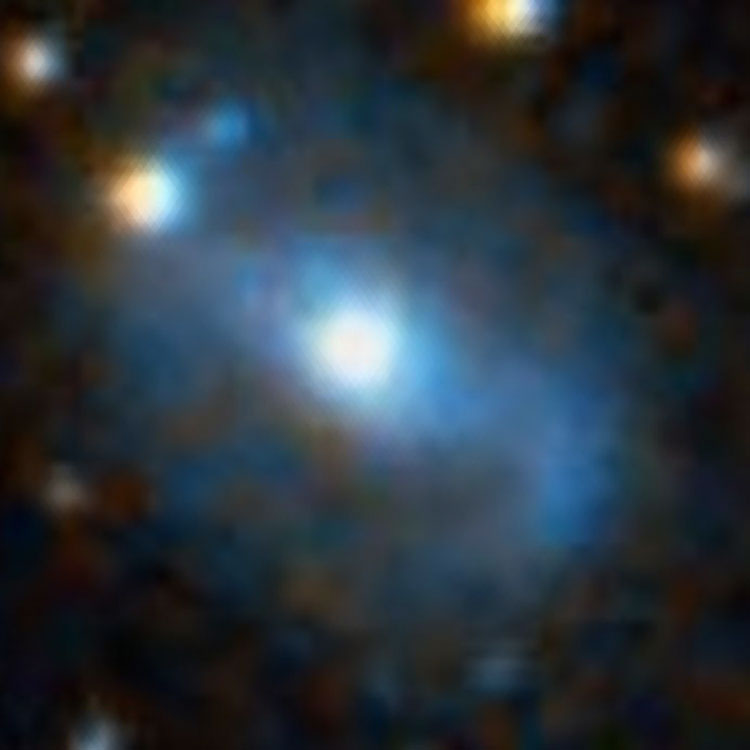
PGC 64458
(= PGC 1150691 = UGC 11537 = CGCG 372-021 = MCG +00-51-013)
A magnitude 14(?) spiral galaxy (type SA(nr,s)c? pec) in Aquila (RA 20 18 38.1, Dec -00 09 02)
Physical Information: Based on a recessional velocity relative to the Cosmic Microwave Background radiation of 5155 km/sec (and H0 = 70 km/sec/Mpc), PGC 64458 is about 240 million light-years away, in good agreement with redshift-independent distance estimates of about 180 to 260 million light-years (the HST press release uses a value of 230 million light-years). Given that and its apparent size of about 2.9 by 0.65 arcmin (from the images below), the galaxy is about 200 to 205 thousand light-years across.

Above, a 12 arcmin wide SDSS image centered on PGC 64458
Below, a 4 arcmin wide SDSS image centered on the galaxy

Below, a 0.75 by 1.5 arcmin wide image of central quarter of the galaxy (North on right to allow for more detail)
(Image Credit ESA/Hubble & NASA, A. Seth)
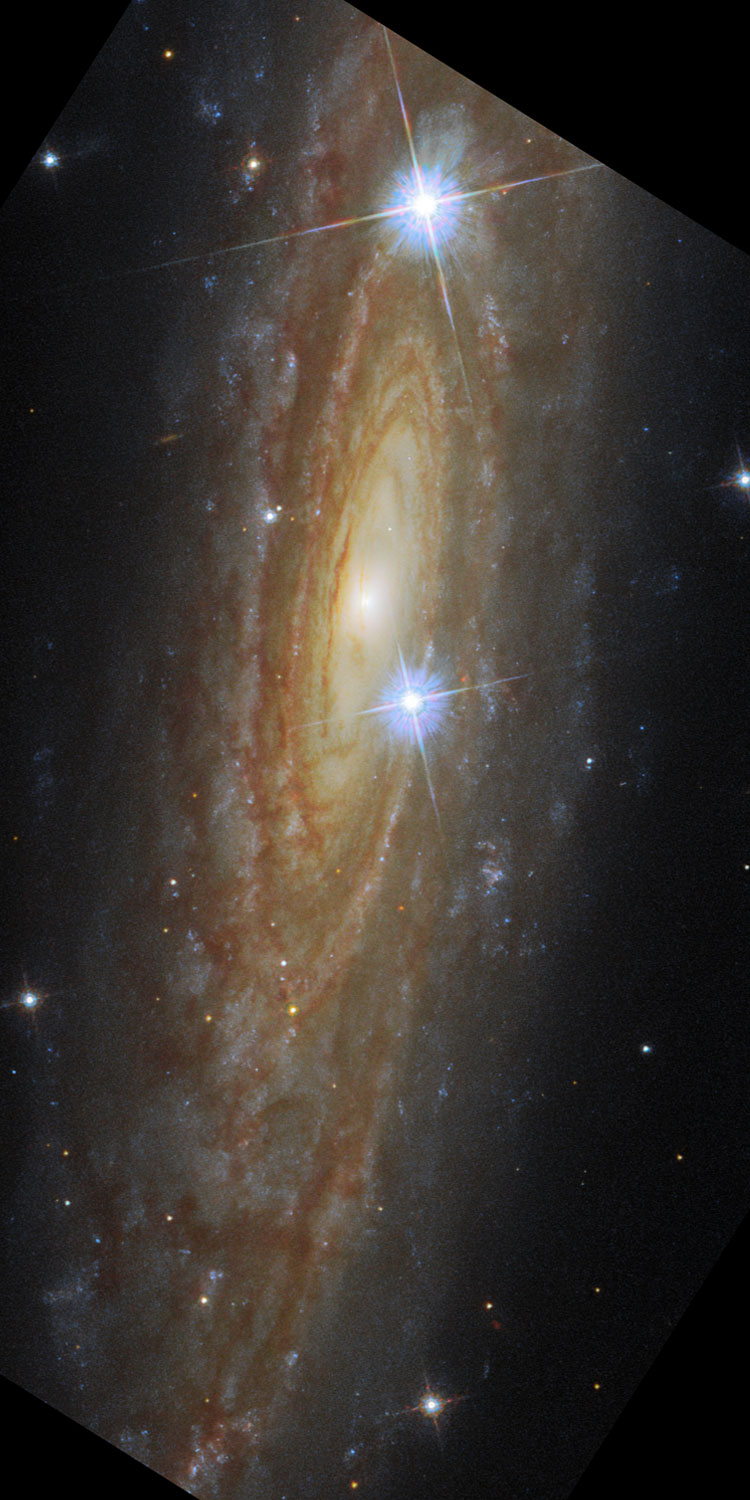
PGC 64488
(= ESO 340-017 = MCG -07-41-030)
A magnitude 13(?) spiral galaxy (type SB(sl)d) in Sagittarius (RA 20 19 41.7, Dec -39 17 19)
Classification Note: The type is taken from the Spitzer Survey of Stellar Structure in Galaxies. The "l" in "sl" means that the central part of the galaxy contains a "lens", a linear structure similar to a bar, but more like a flattened ring than an actual bar.

Above, a 12 arcmin wide DSS image centered on PGC 64488
|